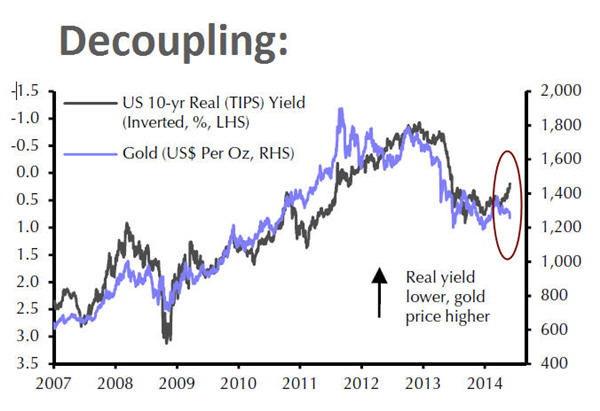CHART: Gold price vs rates shows rally catalyst ‘already in place’
A number of gold market analysts have made the case that the one major factor influencing the price of gold is US inflation-adjusted interest rates and that the correlation is so strong that the gold price can be used as a predictor of rates, serving as an early warning system on both the direction and magnitude of moves.
The underlying reason for the relationship is that as yields rise, the opportunity costs of holding gold increases because the metal is not income producing. Higher rates also boost the value of the dollar which usually move in the opposite direction of the gold price.
Recently though this inverse correlation is between US 10-year real yields (Treasury Inflation Protected Securities or TIPS) and the price of gold has broken down.
The 10-year TIPS is currently at 0.32% (which is consistent with a gold price north of $1,400), down from 0.68% two months ago.
In a new research note Julian Jessop Head of Commodities Research at Capital Economics says this is a bullish sign for the gold price:
“This decline at least partly reflects growing speculation that the neutral level for official interest rates in the longer term has fallen, which should reduce the opportunity cost of holding gold,” says Jessop.
The independent macro-economic research house notes based on the decoupling evident on this graph “there is already a catalyst in place for a near-term rally in the price of the precious metal”.
While US rates have not risen as expected, Europe’s central bank is on the verge of moving rates below zero and may launch a full-blown quantitative easing program later this year and Japan is likely to extend its asset purchases through 2015.
“Unless there is a decisive move below $1,200 per ounce, which seems unlikely given the (rising) floor set by mining costs, we are therefore retaining our end-2014 forecast of $1,450,” the report concludes.

Source: Capital Economics
{{ commodity.name }}
{{ post.title }}
{{ post.date }}

Comments